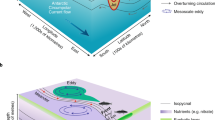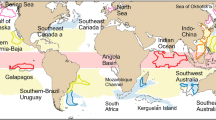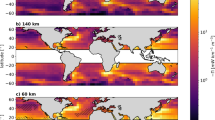Abstract
THE ocean has considerable spatial and temporal heterogeneity in biomass and productivity owing in part to the effects of ocean circulation and mixing1,2. Water mass boundaries (fronts) in coastal waters are well-known sites of enhanced biological activity3,4. Comparatively little is known of open-ocean fronts, and one of the few biological studies of an oceanic front showed phytoplankton biomass at only slightly higher densities than in surrounding waters5. Here we present photographs and measurements from satellites, aircraft, ships and the Space Shuttle Atlantis which show dramatic biological responses to circulation and mixing processes associated with an open-ocean front. Breaking waves (whitecaps) caused by water turbulence and mixing, and very dark green water caused by extremely high concentrations (>20 mg of chlorophyll a per m3) of buoyant diatoms (Rhizosolenia sp.) made a distinct line in the sea visible for hundreds of kilometres. The line traced the northern edge of a westward-progagating (50 km per day) tropical instability wave (1,000-km wavelength) delineating the boundary between cold, upwelled waters and warmer waters to the north. High phytoplankton biomass and primary production associated with the extensive diatom patches may explain anecdotal observations of high animal abundance along this frontal boundary.
This is a preview of subscription content, access via your institution
Access options
Subscribe to this journal
Receive 51 print issues and online access
$199.00 per year
only $3.90 per issue
Buy this article
- Purchase on Springer Link
- Instant access to full article PDF
Prices may be subject to local taxes which are calculated during checkout
Similar content being viewed by others
References
Haury, L. R., McGowan, J. A. & Wiebe, P. H. in Spatial Pattern in Plankton Communities (ed. Steele, J. H.) 277–328 (Plenum, New York, 1977).
Steele, J. H. in The Ecology of the Seas (eds Cushing, D. H. & Walsh, J. J.) 98–115 (Saunders, Philadelphia, 1976).
Yoder, J. A., Atkinson, L. P., Lee, T. N., Kim, H. H. & McClain, C. R. Limnol. Oceanogr. 26, 1103–1110 (1981).
Marra, J., Houghton, R. W. & Garside, C. J. mar. Res. 48, 851–868 (1990).
Fasham, M. J. R., Platt, T., Irwin, B. & Jones, K., Prog. Oceanogr. 14, 129–165 (1985).
Murray, J. W., Barber, R. T., Bacon, M., Roman, M. R. & Feely, R. A. Science (in the press).
Barber, R. T., Murray, J. W. & McCarthy, J. J. Ambio 23, 62–66 (1994).
Legeckis, R. Science 197, 1179–1181 (1977).
Legeckis, R., Pichel, W. & Nesterczuk, G. Bull. Am. met. Soc. 64, 133–139 (1983).
Miller, L., Watts, D. R. & Wimbush, M. J. phys. Oceanogr. 15, 1759–1770 (1985).
Perigaud, C. J. geophys Res. 95, 7239–7248 (1990).
Hoge, F. E., Berry, R. E. & Swift, R. N. Appl. Opt. 25, 39–47 (1986).
Smith R. C. et al. Appl. Opt. 26, 2068–2081 (1987).
Johnson, E. S. & Murray, J. W. A. Meeting Oceanography Soc. Honolulu, Hawaii, 18–22 July (1994).
Villareal, T., Altabet, M. & Culver-Rymsza, K. Nature 363, 709–712 (1993).
Beebe, W. The Arcturus Adventure 45 (Putnam, New York, 1926).
Knauss, J. A. Tellus 9, 234–237 (1957).
Kemp, A. E. S. & Baldauf, J. G. Nature 362, 141–143 (1993).
Kemp, A. E. S., Baldauf, J. G. & Pearce, R. B. Proc. ODP Sci. Res. (in the press).
Author information
Authors and Affiliations
Rights and permissions
About this article
Cite this article
Yoder, J., Ackleson, S., Barber, R. et al. A line in the sea. Nature 371, 689–692 (1994). https://doi.org/10.1038/371689a0
Received:
Accepted:
Issue Date:
DOI: https://doi.org/10.1038/371689a0
This article is cited by
-
Effective generation mechanisms of tropical instability waves as represented by high-resolution coupled atmosphere–ocean prediction experiments
Scientific Reports (2023)
-
Study of coexisting upstream solitary wave packet and downstream wakes induced by Diaoyu Dao and its affiliated islands detected by satellite sun glitter
Acta Oceanologica Sinica (2023)
-
Fine-scale structures as spots of increased fish concentration in the open ocean
Scientific Reports (2021)
-
Influence of diatom diversity on the ocean biological carbon pump
Nature Geoscience (2018)
-
Recycled iron fuels new production in the eastern equatorial Pacific Ocean
Nature Communications (2017)
Comments
By submitting a comment you agree to abide by our Terms and Community Guidelines. If you find something abusive or that does not comply with our terms or guidelines please flag it as inappropriate.



